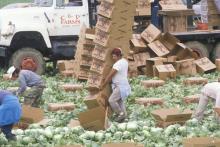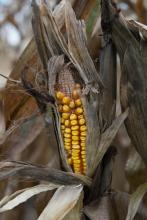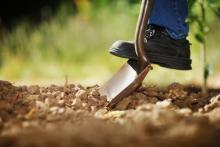farming

The ground on our mountain is rocky ground and the land seems to have more stones on it than soil. I think it is a miracle that things grow here, that things grow so well here. But they do. We are planting, as all farmers do, in the hope that good rains will come and help the seeds grow into whole, full stalks of millet. I am enjoying learning the life of a Malinke farmer. Bala is my teacher. This is his field.

Bio:
Katerina Friesen is studying theology and peace studies at Anabaptist Mennonite Biblical Seminary in Elkhart, Ind.
1. How would you describe your current vocational role?
I see my role as both revaluing what has been cast down and degraded and building resilient communities. So far this has taken shape through land-based ministries of farming and community gardening, inviting people to work together and celebrate the sacramental in soil, food, and one another.
2. You spent several years with the Abundant Table Farm Project in Santa Paula, Calif. Can you describe the project and your role there?
The Abundant Table Farm Project is a working farm and young adult internship program that has evolved into a Christian community. I joined the project in 2009 and lived in community with four other women. My daily work of farming gave me a bodily understanding of farm workers’ labor and the need for justice and wholeness in our incredibly disconnected food system.

Fred Bahnson’s first bit of advice when he started planning a church garden eight years ago came from an elderly tobacco farmer who grabbed a handful of soil, rolled it around in his fingers and shook his head:
“You don wohn fahm heah,” he said in his deep North Carolina drawl.
Those were not the only discouraging words he received as he planted and cultivated one of the earliest and most successful church gardens, 20 miles north of Chapel Hill.
But Bahnson, a Duke Divinity School graduate and a pioneer in the church gardening movement, had a different view of farming than the older tobacco farmer. He knew that if he gave back to the soil more than he took out — in the form of compost, manure and other soil food — he could create an abundant garden.

While relaxing on a friend’s back porch over a spicy vegetarian stew and homemade bread, the conversation turned, naturally, to food. Everyone around the table expressed concern over how much junk food kids eat and how little time children spend outdoors. Our host said that she watches every afternoon as a group of elementary schoolchildren head to the corner market to purchase their after-school snack. Each child comes out with a supersized soda and a bag of potato chips. Not a small bag — the family size, for each child, every day.

America is in dire need of comprehensive immigration reform. It is an ethical and moral issue for sure, but it is also an economic one. Our nation’s future economy prosperity depends on migrant labor. Immigration laws that have been passed in states like Arizona, Georgia, and Alabama have severely hurt the state economies, local communities, and small businesses that rely upon migrant workers for farm labor.
The Senior Editor of CNBC.com, John Carney has asserted that there is no crisis related to a shortage of migrant farm workers. Well, to be perfectly blunt, I believe that Mr. Carney is wrong.

EVEN AS ELECTION-YEAR news cycles move on, the nation faces the aftermath of a prolonged and dramatic heat wave. July 2012 broke two records: It was the both the warmest July ever recorded and the warmest month—period—ever recorded in the lower 48 states. In our home of Chicago, temperatures crept past 100 five times. Moreover, the extreme drought of 2012 is not a random event, but part of a worrisome trend.
Global climate change has come to the heartland. Unless we take collective and decisive action, 102 could become the new 93. And it’s not just armpits and foreheads that will sweat. We have already glimpsed the future, and it is not pretty: massive forests burned in Colorado; major power outages; thousands of acres of crops lost to drought in Illinois, Indiana, Kansas, Missouri, Oklahoma, and elsewhere. These ominous events are indications of the “new normal” unless we make widespread changes in fossil-fuel consumption.
The farming crisis has been acutely severe—and it is directly related to climate change. This summer, the U.S. Department of Agriculture designated more than half of all U.S. counties as disaster areas (1,584 in 32 states). Fred Below, a crop biologist at the University of Illinois at Urbana-Champaign, bluntly summed up the reality: “It’s like farming in hell.”
Ironically, agriculture is the human activity that emits more greenhouse gases into the atmosphere than any other source, including transportation and industry. A key reason: Today’s agriculture intensively depends on burning fossil carbons. (Methane emission from cows and rice fields, and deforestation to clear farmland in the global South, are also contributors.) Being so dependent on fossil fuels means that the food sector is the greatest contributor to global climate change—and that rising oil costs increase food costs, squeezing the poor and marginalized.

Being a teacher is like being a farmer. You rise early in the morning. You irrigate and fertilize the field that is your classroom. You plant the seeds that are reading, writing, and arithmetic. You hope for good soil, warm sunshine, and gentle rain that are good homes, healthy foods, and adequate healthcare for your students. You work with your hands, feet and heart with your plants who are your students.
Your harvest is your students.
Your winter season of fallow fields is your summer break of empty classrooms.

It was a record year for U.S. farmers in 2011, with farm income topping $100 billion. This includes sales of $22 billion in fruits and nuts and $21 billion in vegetables and melons — crops that rely on immigrant farm labor.
But even as U.S. farmers prospered in 2011, those working on farms had less to celebrate.
The nation’s agricultural mecca — Fresno Country, California — had the state’s highest agricultural sales ($5.9 billion) and its highest poverty rate – 27 percent. More than 36 percent of the county’s children were poor, also the highest rate in the state. As one agricultural expert puts it, “High farm sales and high poverty rates often go together.”
Low wages, the seasonal nature of agricultural work, and, for many, unauthorized immigration status make it difficult for farm workers and their families to escape poverty. Farm workers’ high poverty rates aren’t totally attributable to immigration status, but it’s certainly one of the causes: 71 percent of all hired farm workers in the United States are immigrants, and about half of them are in the country illegally.
